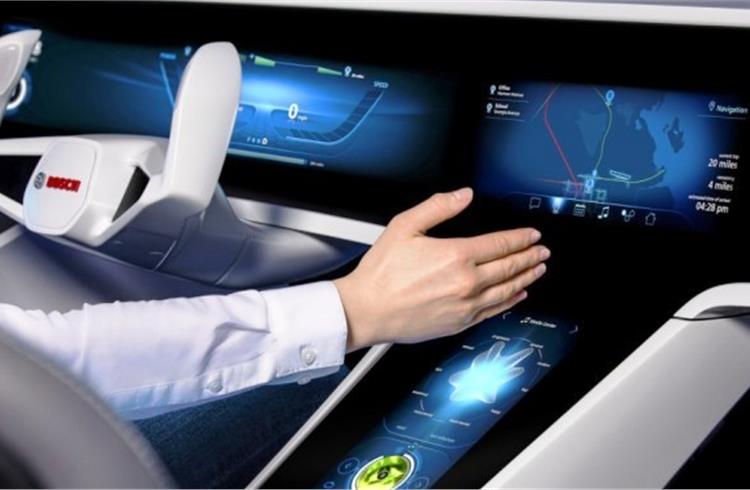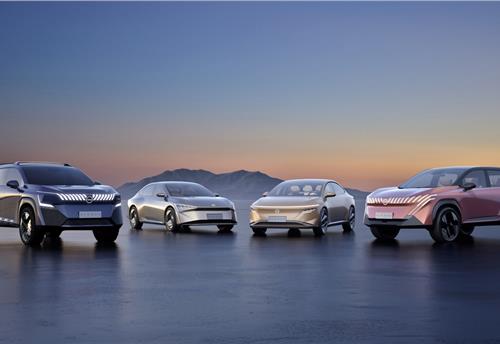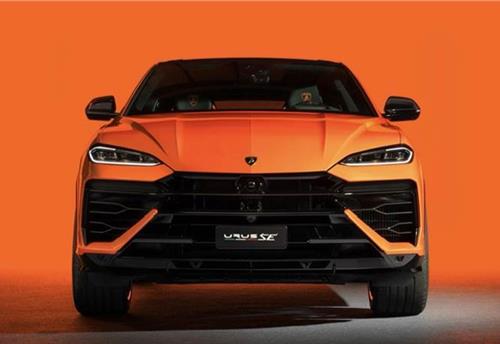Connected cars could save 260,000 accidents by 2025: Bosch
The study claims safety systems and cloud-based functions can prevent around 260,000 injury accidents, save 390,000 tonnes of CO2 emissions and offer drivers many hours of more time for other activities.
Bosch’s has conducted a new study ‘Connected Car Effect 2025’ along with consulting firm Prognos investigating the upcoming trends specifically for the US, Germany and the major cities of China.
The result: safety systems and cloud-based functions can prevent around 260,000 injury accidents, save 390,000 tonnes of CO2 emissions and offer drivers many hours of more time for other activities.
“Connected mobility will mean fewer accidents, less fuel consumption, less stress,” says Dr Dirk Hoheisel, member of the Bosch board of management, summarizing the results of the model calculations.
Assistance and safety systems will become data sources
“The hidden heroes of the connected revolution are assistance and comfort systems, which we are often already familiar with,” says Hoheisel.
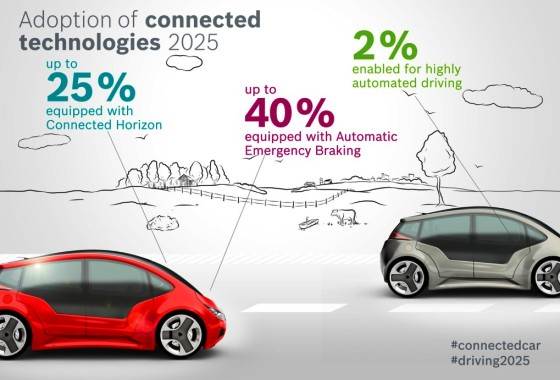
According to the model calculations, the Electronic Stability Program (ESP), for example, will be available in up to 90% of all vehicles in the three countries covered by the study by 2025, with sensor-based automatic emergency braking and lane assists in up to 40 percent of the car fleet. Systems for more comfort and connectivity will also be found in the majority of cars: in 2025, smartphones will be integrated into approximately every other vehicle’s infotainment system.
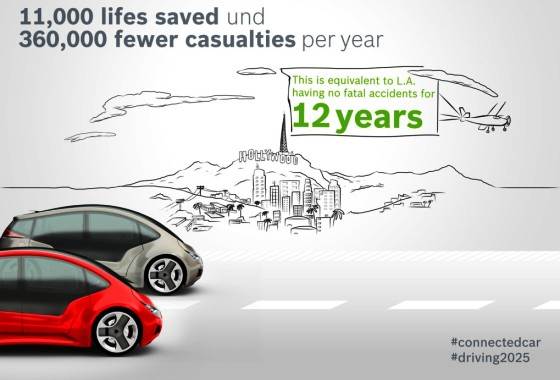
The increasing number of such systems and their increasing connection to the Internet make them far more than the sum of their parts – for everyone involved. ESP sensors will report upcoming sections of icy road, cameras will collect data on speed restrictions and fog, functions such as Internet-based parking solutions and wrong-way driver warnings in virtually real-time will be in widespread use.
Individual findings from ‘Connected Car Effect 2025’
“Our study shows that the effects of connectivity will have a perceptible impact on every driver in 2025,” says Hoheisel. For the study, Bosch and Prognos have produced calculations for the US, China and Germany. Here is a selection of the individual findings:
• Over 260,000 accidents involving personal injuries (US: 210,000, China: 20,000, Germany: 30,000) will be avoided annually – as many accidents as occur within two years in Germany’s capital city of Berlin.
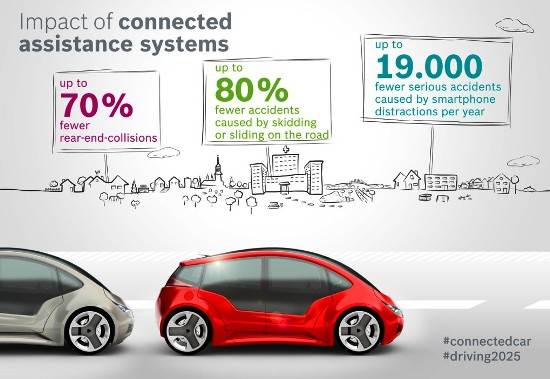
• 350,000 fewer people injured by traffic accidents – the same as 12 years without traffic injuries in Los Angeles. In the US alone, there will be 290,000 fewer (China: 25,000, Germany: 37,000).
• About 11,000 people could be saved through connected assistance systems, 4,000 of whom in the US (China: 7,000, Germany: 300).
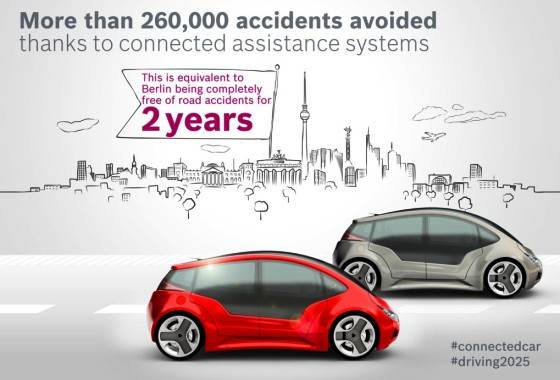
• Up to 4.3 billion euros in material and damage costs will be saved by connected assistance systems. This is nearly double the sum spent by the Chinese government in 2016 to improve air quality in Beijing. These sums mean considerable savings for insurance companies, keeping a little more money in the purse or wallet of every individual vehicle owner. Of the 3.6 billion euros attributable to US’s savings (China: 380 million euros, Germany 450 million euros), smartphone integration alone will contribute over 610 million euros.
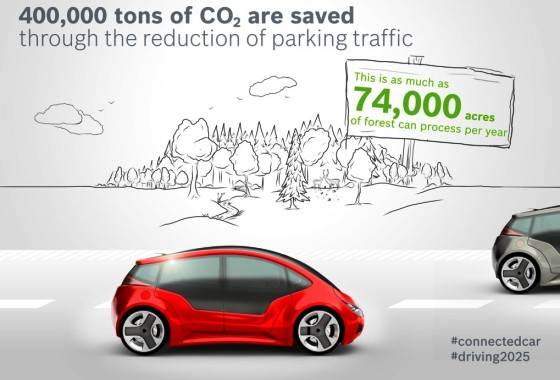
• Nearly 400,000 tons of CO2 will be spared thanks to connected mobility functions – as much as the Black Forest national park in Germany can process in three years. Concepts such as community-based parking and active parking lot management will reduce parking traffic by up to 380 million kilometers, while highly automated driving saves additional fuel.
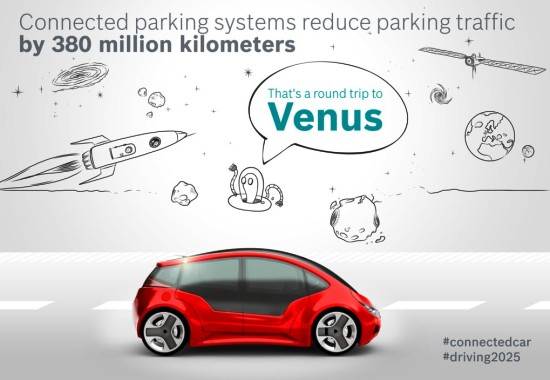
• 70 million driving hours will be shed by connected parking functions in the US, China and Germany. That is as many hours as 40,000 employees work in a year.
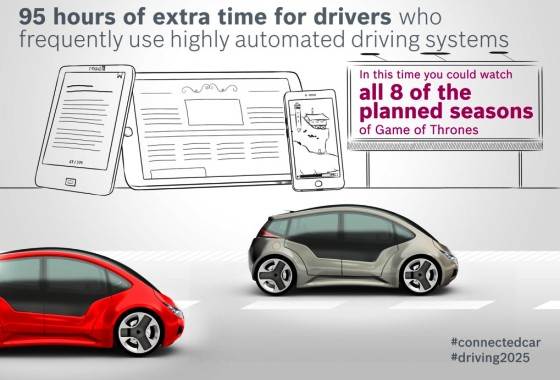
• 31 hours of free time on the highway: US citizens spend 43 hours per year on interstates (China: 26 hours on expressways, Germany: 39.5 hours on highways). Highly automated driving and simultaneous Internet connection will make free around 80 percent of time behind the wheel to be used for something other than driving: reading, emails, video conferencing, films, for example. Frequent drivers who reach 40,000 kilometers of driving a year could benefit from 95 extra hours of productivity during their journeys.
Investigative methodology
Bosch and Prognos assessed a total of 11 technologies for private passenger transport, particularly their dispersion and impacts by 2025 in the US, Germany, and metropolitan areas in China.
“In model calculations, we simulated the speed at which the new technologies would be adopted into the vehicle fleet,” explains Prognos mobility expert Stephan Kritzinger. The model is based on international statistics on vehicle inventories, accident data and current research, as well as estimates by Bosch and Prognos.
Read more: Bosch to showcase IoT at CES 2017
RELATED ARTICLES
Kia displays EV5 and Sonet SUVs for Chinese market
Kia has unveiled a number of key models and new technologies for Chinese customers at the 2024 Beijing International Aut...
Nissan targets growth in China, unveils four NEV concepts at Beijing Motor Show
The two EVs and two plug-in hybrids are a joint effort with Nissan’s local partner Dong Feng and aimed to better address...
Lamborghini unveils Urus SE ahead of Auto China 2024
Electric-only range of 60km helps reduce emissions by 80%.





 By Autocar Pro News Desk
By Autocar Pro News Desk
 26 Dec 2016
26 Dec 2016
 6110 Views
6110 Views



